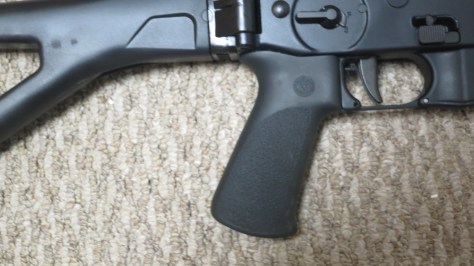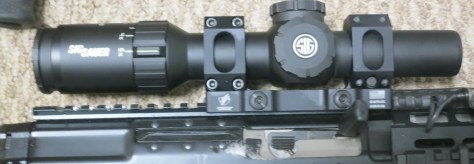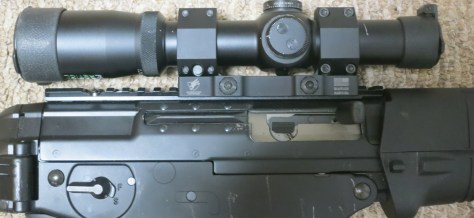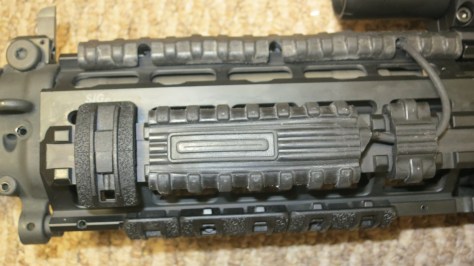On the recent Primary & Secondary modcast 187, Matt was discussing his new DSA FAL and the general concept of taking what was an obsolete battle rifle and making it new again. I thought this was a cool idea, and decided to embark on a similar project. I have a number of relatively obsolete guns in my safe, but a fair number of them are in “mil-spec” configuration, and thus I don’t want to alter them. But I do have a Sig 556 SBR and a Sig 556R Gen2 that are basically just old “cool guy” guns from a decade ago, and thus fair game.
I took a long look at them, and what I thought needed to be improved… and did it.
First, a little history. The Sig 556 is the American version of the Sig SG 550 rifle that the Swiss adopted as their service rifle (which was just a renamed SG 541, but not relevant to this discussion). The Sig 556 was released in 2007, and had some features specifically for the American market, namely an aluminum lower receiver and compatibility with AR-15 mags. The early guns had some dubious AR-style furniture on them, but eventually evolved into the solid Sig 556 Classic and Sig 556 Patrol. American Rifleman has a good article on these rifles that you can reference for further information. Not mentioned in it is the later release of the AK-mag 7.62×39 version, the Sig 556R, or the product-improved Sig 556xi. The 556R itself had a couple of generations to it, with modifications involving enlarging the ejection port, modifying the magazine catch mechanism, feed ramp modifications, and stronger springs. (If you got a Gen1, you were able to send it in to Sig for the upgrades for a very nominal fee, which is what I did.)
Coincidentally, the Sig 556 is more relevant to this blog than you might imagine, because it appears that some of the early Sig 556 parts were made in Israel! I know the AR-style stock and the handguard rails were, in particular.
The Sig 556 platform is both discontinued and obsolescent. The charging handle is reciprocating, and on the right side of the gun (which is the wrong side for a right-handed person). The bolt catch/release is on the small side, and even harder to use than on an AR-15. The factory front sight is large and hooded, requires a wrench to adjust windage, and manages to get in the way of optics even more than an AR-15 fixed front sight does. Speaking of optics, the sight plane for the backups is about 1.1″, which is nearly half an inch below where AR heights hang out – which is to say, your options for sights with a good cheek weld are rather limited at this point of the game. I also don’t love the fat factory pistol grip, albeit that’s a personal preference. The trigger is mediocre – a bit better than a factory Tavor’s, but not by much. The handguard is pretty loose – not a good platform for lasers, but serviceable for lights and foregrips – and the quad rail is rather heavy.
But the platform also has some nice points, too. The barrel is light, the gun balances well, it has a good twist rate, and takes industry standard muzzle devices. The safety selector and magazine release on later models (both 556 and 556R) is ambidextrous. The rear backup sight folds flat to the rail, and is easy to adjust (albeit with a tool). The stock folds, looks cool, and if you’ve got a Swiss stock, is quite solid and comfortable.
In summary, there’s some raw material we can work with, but it’s going to require some upgrades.

The first, and I’d argue most necessary, upgrade I made was to the pistol grip. Hogue sells an absolutely excellent “no finger groove” pistol grip that I recommend with no hesitation. Not only is this grip much more comfortable than the SAW grip, but it puts your hand in a much better position to work the safety quickly.

Second, I wanted compatibility with my Silencerco ASR suppressors. I took the uppers off, clamped them into a barrel vise, and wrenched off the factory A2 muzzle devices, replacing them with ASR devices. Both rifles are rather over-gassed (even on “normal” gas), but they’re usable in a pinch. I saw a guy on ARFCOM once upon a time who was drilling suppressor gas valves (albeit at $150 a pop), so maybe I’ll take advantage of that eventually. But, besides cost, there’s basically no downside to ASR muzzle devices, so they’ll work. The brake does a pretty nice job of controlling recoil on the 556R, too.
Third… dealing with the sighting system situation. As I noted above, the Sig 556’s low 1.1″ sight height reduces your options considerably in terms of your optics, unless you are willing to either sacrifice good cheek weld, or go with a riser (which would mean no factory backup sights). Neither of these were appealing options for me.
After surveying my options, I decided that a low-power variable optic scope seemed like the right answer for my situation. I selected two different scopes, optimized for each platform.

For the Sig 556 SBR, I went with the Sig Optics Whiskey5 1-5×24 scope. This is a Japanese-made, 30mm tube scope that provides a “duplex with center circle” reticle that utilizes a very bright fiber optic aiming point. This scope is an SFP scope. I don’t love SFP scopes, but in this particular case, it made sense since I only anticipated using the Sig at ranges where a battle zero would prove effective (which is basically 0-300 yds) and the reticle had no BDC anyways. Essentially, it’s a reflex sight that I can crank up to 5x magnification. The glass is absolutely magnificent (which makes sense, given its MSRP and origin). For the street price (I paid < $500), it is a superb alternative to many of the lower-end 1-6x scopes floating around.

For the Sig 556R, I used the Pride Fowler RR-EVOLUTION-BLK 1.25-4x FFP scope. I had acquired this scope for a different build a number of years ago. I have mixed feelings about it these days. The reticle is absolutely excellent. But they made a number of really questionable design decisions with the rest of the scope: they included scope caps on a “whole eyepiece turns” magnification design, the turrets aren’t capped (hard to forgive on an FFP BDC scope!), the zero marks on the scope body are hard to see, and the glass isn’t earth-shattering for the price point. It is still serviceable and very usable, but I suspect the PA 1-6x 300 AAC FFP scope is a much better value these days.
The mount was a real consideration. Given that I wanted to be able to retain use of my backup sights, QD was a necessity. And as luck would it have it, American Defense Manufacturing makes the AD-RECON-SL mount that puts your scope at 1.1″ – exactly where I need it. I looked online everywhere for someone who had tried using this mount for that purpose on the 556 platform, and came up with zero examples. But, nothing ventured nothing gained, so I bought one anyways.
I was pleasantly surprised to discover that my measurements were correct, and the mount put the scope at exactly the right height. When mounted forward on the receiver, I was able to use an aggressive “nose to receiver” stance that provided consistent correct eye positioning. I highly recommend LPVOs on these rifles.
However, once I mounted them on, I discovered that the huge factory fixed front sight made it very difficult to use the scopes on 1x, as much of the sight picture was obscured. The solution for this on an AR is to use a folding front sight, so I went the same way on my Sig guns.

MFI makes a Sig 556 folding front sight. It is a little difficult to figure out which one you need, because the Sig 556 apparently has cycled through a few sight heights over time. However, I ordered a pair of these, and they seemed to be the right height. I also got a few extra roll pins, given that they were cheap and liable to be needed (they were!).
The instructions to install the sight are straightforward. You pop a roll pin out of your factory sight’s bolt, unscrew it, and then use a brass punch to push the sight off. You then just follow the process in reverse to put the MFI sight on. It is is a little tricky to get the roll pin back in, and I destroyed a couple of roll pins attempting it. One thing I found useful was to insert a small roll pin punch to hold the screw and bolt in place while pushing the roll pin in from the other side. If you keep your wits about you and have a roll pin punch set, this installation is not difficult.
The MFI sight is solidly constructed, but has an unprotected folding front sight post. I don’t think it’s likely to be damaged by a rifle drop when folded down, but I would not want to bet heavily that it would keep straight if it was folded upright and you dropped the rifle on it. It’s an emergency sight, and not what I would use for a daily driver iron sight (the factory sight works fine for that). To be fair, the factory folding rear sight isn’t much better in this respect, so I find it be a very acceptable trade-off in return for a clear sight picture when my LPVO is on 1x. If your iron sight is in the way of your scope, the MFI sight is the way to go, hands-down. I wish I had made the switch years ago.

Finally, I wanted to add weapon lights to these guns. I had some Surefire XM07 tailswitches with remotes lying around, so I bought a pair of Surefire 6Ps, replaced the bulbs with modern LED emitters. To deal with wiring on the Sig 556 SWAT’s quad rail, I used Manta Defense’s wire management system. The Manta wire management system is more designed for legacy quad rail platforms, but I think it holds up fairly well, and I got it pretty cheap to boot. The important thing about using the XM00 tailswitch is that it gives you both a remote and a push-button for activation; given how often remotes go down, I tend to not trust them unless I have no other choice. This made the Sig 556’s handguard somewhat crowded, but there was still enough room to get a good grip.
The lights were mounted on a Fab Defense PLR, and an Olight E-WM25. The Olight E-WM25 is surprisingly not bad for the $13 it costs; it has a tool-less mount, it self-adjusts for slight flashlight diameter size variations, and the offset is almost 100% vertical (versus the overly-horizontal offset you see in the $3 mounts). The Arisaka and PLR are both better mounts, but sometimes you just don’t want to spend the money right then and there.
Do these upgrades change the entire character of the rifle? No, probably not. You’re still dealing with that right-hand-side reciprocating charging handle, and the trigger remains meh. They’re also substantially heavier than a comparable piston AR. The lack of MLOK handguards is quite painful, and is going to be an issue in another decade, I imagine.
Do they make it far more competitive with a modern AR? Yes. The ergonomics are much improved, you can use a suppressor, and the clear field of view for the LPVO makes it a much more effective weapon at shorter ranges compared to the factory sights. Ballistic Magazine seems to have come to a very similar conclusion in their testing.
The Sig 556 platform would not be my choice over, say, a Beretta ARX-100, Sig MCX, or IWI Galil ACE, but it now gets the job done in a way that it didn’t back in 2010. Don’t underestimate the effectiveness gains that can come from upgrading an older rifle to modern standards, but at the same time, if you’re starting from scratch, picking an older rifle isn’t really the way to go.


Nice mods. I’d add the Krebs safety lever as another worthy upgrade.
–Robert
LikeLike